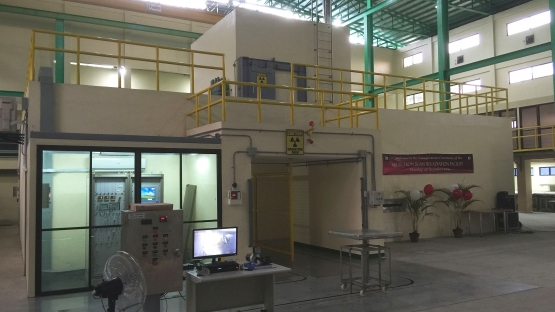In the 55 years since their inception, electron beams have found numerous peaceful applications in industry, healthcare and scientific research. By manipulating electric and magnetic fields, free electrons in a vacuum can be made to form a fine, uninterrupted beam of kinetic energy. These 'e-beams' can be precisely controlled to deliver an equally precise dose of heat or energy to solid-state matter, whether it's human tissue or a steel cable.
Through an ongoing technical cooperation (TC) project1, the Philippines now counts itself among the few developing countries with a fully-functional and operational e-beam facility, a service which will deliver a notably positive economic impact to the country's growing cable-production sector. The e-beam facility, which is located at the Philippines Nuclear Research Institute (PNRI), was officially inaugurated on December 3, 2014.
The annual average production of wires and cables in the Philippines is estimated at approximately 60 million metric tons. Prior to collaboration with the IAEA, these cables were produced through "chemical crosslinking," a process which is notoriously slow, cumbersome and often unnecessarily expensive. The use of e-beam technology to produce industrial wiring has been commercialized elsewhere in the region, and has thoroughly demonstrated its cost- and time-effectiveness. By implementing the TC project, the Philippines not only stood to develop new industrial capacities, but would economize the production of cross-linked cables, heat-shrinkable tubes and sheets.
As part of its design, the TC project sought to develop the necessary human resources to maintain the state-of-the-art 100kW e-beam facility. Five IAEA fellows completed training in Viet Nam, Canada, Poland and the Republic of Korea. Further capacity building came in the form of two scientific visits, and an expert mission which focused on the radiation-processing of polymers. Not only did these training modules strengthen capacities in the maintenance of an e-beam facility, they inculcated the staff with the best quality assurance and dosimetry practices, ensuring a higher level of operational safety, both for the on-site experts and the general public.
The new electron beam facility has been set up adjacent to the existing gamma radiation processing plant, enabling the complementary facilities to address a large number of applications that will support progress in the field of peaceful utilization of radiation energy, and thus will promote the radiation processing in the country. The facility will also act as a knowledge center that will aim at training experts to undertake pioneering research in the field of radiation processing of industrial products. Furthermore, the new facility will help entrepreneurs to establish cost-effective technologies for producing advanced materials, thereby reinforcing the competitiveness of the Philippines in this growing market.
1 PHI/1/017


